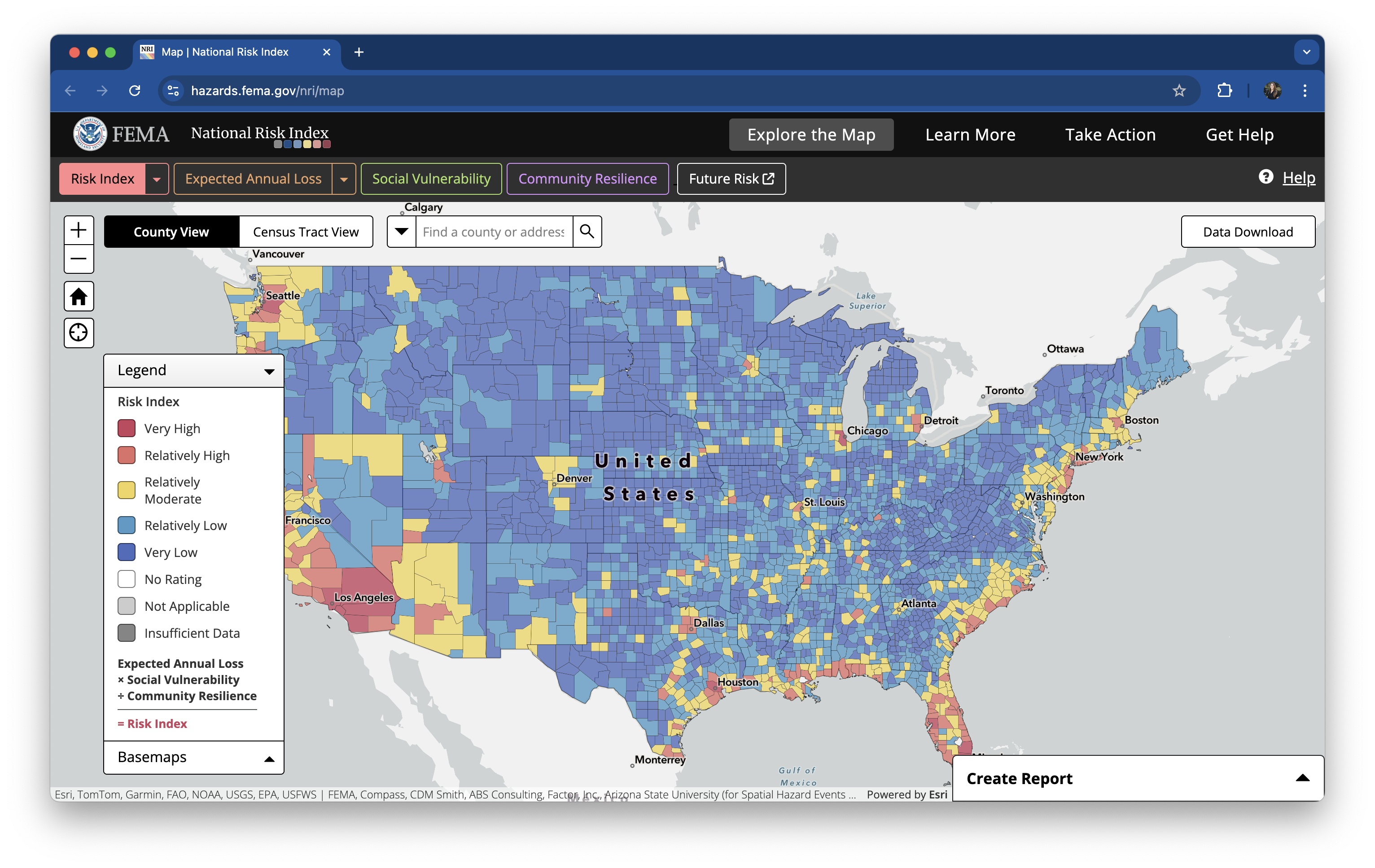Screenshot of the The National Risk Index’s interactive mapping and data-based interface

Course materials are currently undergoing revision! EDS 240 will begin again in January 2026. In the meantime, things here might get a little messy
Assigned Wed 01/21/2026 | Due Wed 01/28/2026
{ggplot2} + ggplot2 extension packagesIn class, we’ve been discussing strategies and considerations for choosing the right graphic form to represent your data and convey your intended message. Here, you’ll apply what we’re learning while exploring natural hazards data, courtesy of the FEMA National Risk Index (NRI).
Read more about FEMA’s NRI before continuing on (unfold the following note, which is collapsed to save space):
FEMA (Federal Emergency Management Agency) is a government agency with a mission of helping people before, during, and after disasters. In 2021, FEMA launched the National Risk Index (NRI), “a dataset and online tool to help illustrate the United States communities most at risk for 18 natural hazards”.
Risk is defined as the potential for negative impacts resulting from natural hazards. It’s calculated using the following equation (and illustrated in this graphic; read more about determining risk):
\[Risk\:Index = Expected\:Annual\:Loss \times \frac{Social\:Vulnerability}{Community\:Resilience}\]
NRI provides hazard type-specific scores, as well as a composite score, which adds together the risk from all 18 hazard types. A community’s risk score is represented by its percentile ranking among all other communities at the same level for Risk, Expected Annual Loss, Social Vulnerability and Community Resilience – for example, if a given county’s Risk Index percentile for a hazard type is 84.32 then its Risk Index value is greater than 84.32% of all US counties. Each community is also assigned a risk rating, which is a qualitative rating that describes the community in comparison to all other communities at the same level, ranging from “Very Low” to “Very High.”
You can learn more about the NRI at hazards.fema.gov/nri.

Screenshot of the The National Risk Index’s interactive mapping and data-based interface
Data at the county- and census tract-level are available for download in multiple formats (including Shapefiles & CSVs) from NRI’s Data Resources page.
eds240-nri-acs-viz GitHub repoCreate a public GitHub repository named eds240-nri-acs-viz and add the following:
For this assignment, you’ll only be working with FEMA NRI data. During HW #3, you’ll be asked to incorporate American Community Survey (ACS) data (hence the repo name, eds240-nri-acs-viz).
Next, let’s download the necessary data, and add it to our eds240-nri-acs-viz repo:
Create a data viz that helps to answer the question, How do FEMA National Risk Index scores for counties in California compare to those in other states? This may require some data wrangling.
NRI_Table_Counties/ contains a metadata file named, NRIDataDictionary.csv, which describes each of the variables found in the data file (NRI_Table_Counties.csv). This is a helpful place to start!Your final visualization should:
.qmd file? Adjust the aspect ratio!
You can adjust the aspect ratio of your plot (i.e. its width to height ratio) so that your data / groups are easy to read. Add the fig-asp option to your code chunk YAML, which makes adjusting aspect ratios for rendered outputs quite easy. Values > 1 make your plot taller and values < 1 make your plot wider.
There are a number of different chart types that could work for these data and question, however we do not intend for you to build a choropleth map (e.g. replicating what you see on the The National Risk Index’s interactive mapping and data-based interface).
To recieve a “Satisfactory” on HW #2: